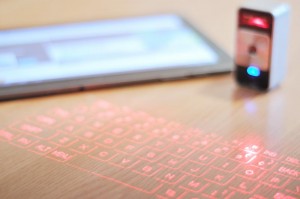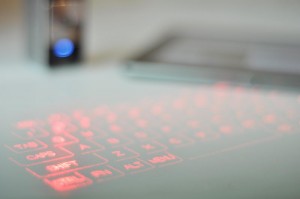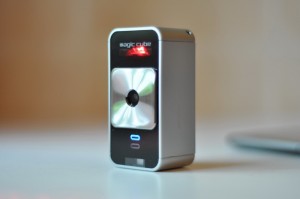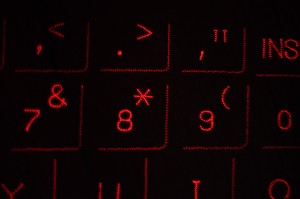A projection keyboard is a form of computer input device whereby the image of a virtual keyboard is projected onto a surface: when a user’s fingers are placed on the projected “keys”, the device translates them into keystrokes.(Source)


A projection keyboard generally works by:
1.A laser or beamer projects visible virtual keyboard onto level surface
2.A sensor or camera in the projector picks up finger movements detected co-ordinates determine actions or characters to be generated
Some devices use a second (invisible infrared) beam:
1.An invisible infrared beam is projected above the virtual keyboard
2.Finger makes keystroke on virtual keyboard. This breaks infrared beam and infrared light is reflected back to projector
3.Reflected infrared beam passes through infrared filter to camera
4.Camera photographs angle of incoming infrared light
5.Sensor chip determines where infrared beam was broken detected coordinates determine actions or characters to be generated
The laser keyboards use laser and infra-red technology to create the virtual keyboard and to project the hologram of a keyboard on a flat surface.


The projection is realized in four main steps and via three modules: projection module, sensor module and illumination module. The main devices and technologies used to project the hologram are a diffractive optical element, red laser diode, CMOS camera and sensor chip and an infrared (IR) laser diode.
Although projection keyboards are impressive, both in terms of technology and innovation, their performance is still limited when compared to a simple, traditional switch keyboard. Cost is also a concern, going for a ratio of 1:40 when comparing a simple keyboard with the more advanced, projection keyboards.
I’m sure the next few years will come with improvements to the current drawbacks and this technology will gain a lot of popularity.

This is a very interesting invention. You know I am actually thinking that in the next few years computer scientists will be able to create projected images that carries with them a virtual signal. Remember how a bluetooth works? What if the file being sent through this kind of signal can be stopped, hovered and cultivated to transfer signals to and from the device? Wouldn’t that be great? It is the advent of the future and the innovation to hologramic visuals is just a fingertip away! Thanks for the great post!